Rupture disc devices provide overpressure protection for a variety of storage and process vessels and equipment. The objective of the rupture disc is to maintain a leak-tight seal and be a passive bystander until called upon to relieve excess pressure. While this is generally the case, there are times when rupture disc performance can be adversely affected through various installation, operation and maintenance practices.
This article reviews some of these practices, real-life observed consequences, and corrective or preventative measures that can improve rupture disc performance.
Liquid service
Liquid-full systems create a number of processing challenges, many of which apply to rupture discs. Pressure spikes and water hammer generated by rapid opening or closing of valves somewhere in the process frequently do affect the rupture disc. The typical rupture disc begins to respond to pressure in excess of the burst pressure in less than 1 millisecond. This means that a short-duration pressure spike that is not detectable by normal process instrumentation can and will affect the rupture disc. Ways to avoid pressure spike problems include: avoiding the use of rupture discs on long, liquid-filled lines, eliminating fast-closing-and-opening process valves, and using pressure accumulators to absorb the unavoidable pressure spikes.
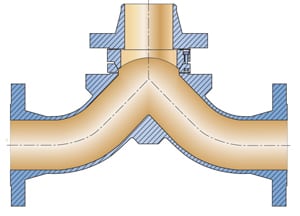 |
| FIGURE 1. This viscous-tee holder design continually wipes the disc surface, preventing product buildup |
Common indications that you have a water hammer or another pressure spike problem include the following:
-
The rupture disc appears to burst at a pressure lower than the marked burst pressure
-
The rupture disc is only partially open
-
Ruptures are observed during or immediately after some non-steady state condition in the process
Solidifying materials
This is a combination rupture-disc-selection and piping-design problem. Many process materials are prone to building up and solidifying on internal surfaces. This can create a problem for the typical vessel discharge port that may become partially or completely blocked, resulting in potentially higher than expected rupture-disc burst pressures and restricted discharge flow. Common solutions to this problem include the following:
-
Use of heat tracing or steam jacketing around the vessel nozzle and rupture disc holder
-
Use of a “viscous tee” style holder (Figure 1), which continually wipes the disc surface, preventing product buildup
-
Use of a flush-mount-style rupture-disc assembly, which eliminates any dead space in the vessel nozzle that could accumulate solidified materials
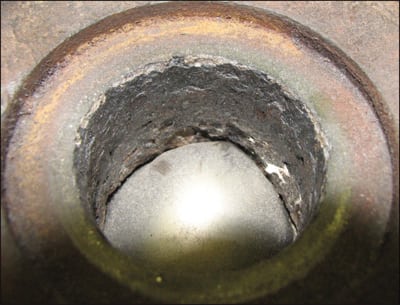 |
| FIGURE 2. This rupture disc holder has been subjected to heavy corrosion |
Piping
The influence of piping and piping-support design on the rupture disc is often overlooked but has been the source of many problems. The most common problem is the transfer of excessive piping loads to the rupture disc. This can be caused by very tall discharge pipes; long, horizontal pipe runs; or severely misaligned pipe flanges.
The most common symptom of a piping problem is rupture disc leakage due to uneven loading of the metal-to-metal sealing surfaces. This issue can usually be resolved with strategic placement of piping supports.
Another piping-related source of trouble is the failure to vent or account for drainage of discharge lines. Heavy corrosion of the rupture disc holder can result (Figure 2). Also, condensate in the discharge lines can freeze, and the expansion during the freezing process can collapse a forward-acting rupture disc (Figure 3).
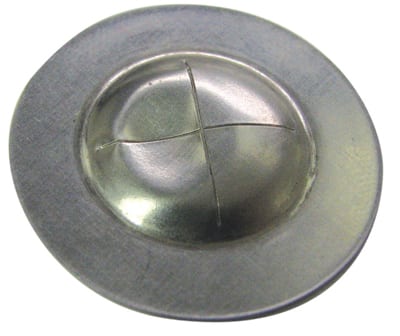 |
|
FIGURE 3. The damage on this forward-acting rupture disc is a result of freezing condensate |
Flange connections
Most rupture discs function in conjunction with a holder that contains key interface features that help control bursting characteristics and effect a leak-tight seal. The goal of the flange connection is to apply the proper amount of clamping load for the rupture disc and holder to function correctly. This clamping load is affected by the torque applied to the studs, the type of lubrication on the studs, the type of flange gaskets used, and the general alignment of the pipe flanges.
Indications that you have an under or unevenly loaded rupture disc include the following:
-
Leakage between the rupture disc and holder
-
Rupture disc slippage
-
Increased variation in burst pressure
Indications that you may have an over-loaded rupture disc include the following:
-
Leakage between the rupture disc and holder
-
Increased variation in burst pressure
-
Permanent damage to the holder
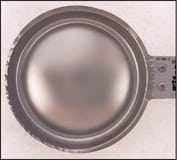 |
| FIGURE 4. Wrinkles on the outer edge of a rupture disc indicate slippage from uneven torque |
Torque: All rupture discs have a recommended torque provided by the manufacturer. This information may be located on the rupture disc tag or in the installation instructions provided. This torque value is generally associated with some common thread lubricant. Torquing should always be done in a criss-cross pattern in increments of no more that 25% of the final torque value to ensure evenly developed loading (Figure 4). It is generally a good practice to re-torque the studs after a period of time and after the system has come up to operating temperature to compensate for the normal relaxation of bolt loads.
Lubrication: Thread lubrication can drastically affect the resultant load achieved from an applied torque. Dry unlubricated threads are more prone to corrosion and galling, resulting in an under-loaded rupture disc that might exhibit leakage, slippage, or inconsistent burst pressures. Threads lubricated with high performance lubricants, such as PTFE, moly-disulfide or graphite, may result in an overload condition.
Gaskets: Flange gaskets have an effect on the applied load as well. Soft gaskets, such as PTFE, while great at conforming to imperfect surfaces, are subject to cold flow. The result is that a short period of time after applying the correct load, the gasket will have further compressed and released most of the load. Some gaskets may have a higher required load than that of the rupture disc. Consult the disc manufacturer to verify the higher load will be acceptable.
Maintenance activities
Rupture disc devices require periodic maintenance just like any other piece of equipment.
Device removal: The entire device (rupture disc and holder) can be removed from the flanged connection and inspected. The device may be re-installed if desired as long as the disc hasn’t been removed from the holder. Pre-torque style holders are frequently used in applications where physical inspection and re-use of the rupture disc is desired as the holder maintains load on the disc even after removal from the pipe flanges. Once the disc has been removed from the holder it is recommended that the disc be replaced. Due to the metal-to-metal sealing surfaces, any re-installation of a rupture disc is likely to seal less effectively. Also, some rupture disc types may exhibit increased burst pressure variability when re-installed.
Disc inspection: The value of rupture disc inspection is limited to signs of damage, corrosion, or product buildup. No information about the disc integrity or remaining life can be determined through visual or dimensional inspection.
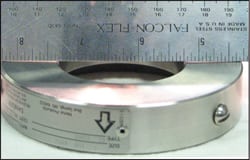 |
| FIGURE 5. This holder shows deformity due to excessive torque. Ideally there should be no gaps between the holder and a straight edge |
Holder inspection: Holder inspection should include examination of the seating surfaces for damage, corrosion, or product buildup. A quick way to check for holder damage due to over-torque is to put a straight edge along the gasket face and look for signs of significant bending (Figure 5).
Maintenance frequency
While rupture disc manufacturers would like to recommend replacement of every rupture disc every year, that is not a realistic expectation. As shutdowns for maintenance activities are stretched further and further apart, it is not unusual to expect 3 to 5 years of service from the rupture disc. Rupture disc life is generally tied to the stress history (pressure and temperature) applied to the disc. Relatively low pressures and static conditions will generally result in very long disc life, while cyclic conditions approaching the burst pressure will result in shorter disc life. There is no one, right answer regarding replacement frequency, but common considerations include the following:
-
Severity: What is the severity of the service the rupture disc is subjected to? Consider corrosion, operating pressure, cyclic duty and so on.
-
History: What is the history of the rupture disc location? Has it been prone to premature fatigue type failures?
-
Cost: What is the cost of an unexpected outage due to premature burst versus the cost of a replacement rupture disc during planned downtime?
-
Upgrade: Are there other disc materials or newer disc technologies that will allow the maintenance interval to extend beyond current limitations? What is the payback on such an upgrade?
When a rupture disc bursts unexpectedly, the user should look for the obvious pressure or temperature excursions in the process that may have initiated the bursting of the disc. If the cause is not apparent, it is time to engage the manufacturer to assist in troubleshooting the problem. When rupture disc problems are experienced, it is important to gather as much information as possible to arrive at resolution quickly. The following items form a good starting point for data collection:
-
Rupture disc lot number
-
Date installed
-
Date of burst
-
Actual normal and maximum operating pressure
-
Actual normal and maximum operating temperature
-
Vacuum conditions: yes or no
-
Cyclic conditions: If yes, describe
-
Liquid or vapor
-
Discharge to atmosphere, pressure relief valve or header
-
Rupture-disc performance history in this location
-
Photos of rupture disc, holder, installation
-
Signs of abnormal operation: for example, pin-hole opening, partial opening, slippage and corrosion products
Rupture discs generally provide highly reliable pressure relief, so in the case of problem installations there are likely actions that can be taken to improve rupture disc performance. Partnering with your rupture disc supplier to investigate and evaluate these situations will promote opportunities to improve rupture disc performance, extend maintenance cycles and reduce long-term costs.
Edited by Dorothy Lozowski
Author
Editor’s note Both disk and disc are commonly used spellings of the word in industry. The editors have chosen to use the spelling of the author in each article of this series. |
 Dean Miller is the manager of mechanical engineering with Fike Corp. (704 SW 10th St., Blue Springs, MO 64015; Phone: 816 – 655-4729; Email:
Dean Miller is the manager of mechanical engineering with Fike Corp. (704 SW 10th St., Blue Springs, MO 64015; Phone: 816 – 655-4729; Email: